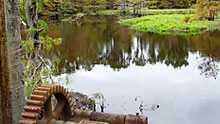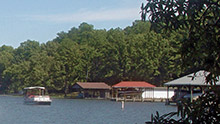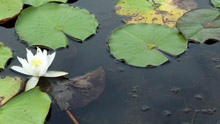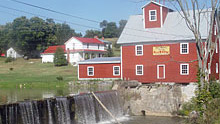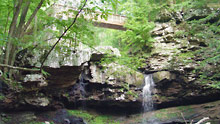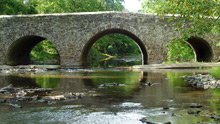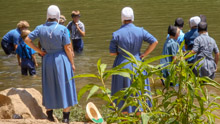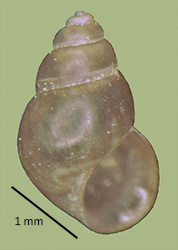> Habitat & Distribution
Thompson (1999) gave the range of L. monroensis as "widely distributed in brackish marshes and streams from Georgia to Mississippi, enters fresh water in Florida throughout the St. Johns River." Thompson (1968) mapped populations up and down both coasts of Florida and documented several records from The Bahamas. More recent molecular evidence suggests invasions in both the Chesapeake Bay (Wilke et al. 2001) and in the San Francisco Bay area as well (Hershler et al. 2007). Maximum abundances are typically found on aquatic vegetation and grasses.
Although the FLMNH holds quite a few collections of L. monroensis from brackish environments in the Florida panhandle, we are not aware of any freshwater populations in our Gulf-drainage study area. FWGNA incidence unranked.
> Ecology & Life History
Hydrobioid snails seem to be rather nonspecific grazers of small particles (Dillon 2000: 94-97). They are typically dioecious; the males being characterized by a penis that arises from the neck. Females typically attach single eggs in spare, hemispherical capsules to solid substrates, although Hershler & Thompson (1992) transmitted an intriguing observation from Richard Heard of pelagic larvae for a population of L. cf. monroensis.
Thompson (1968) characterized L. monroensis populations as euryhaline, extending into salinities approaching 20 ppt. He went further to suggest that "The species undoubtably can tolerate a greater salinity than this, for it has been found in tidal marshes that nearly dry up due to evaporation."
> Taxonomy & Systematics
The species was originally described as Hydrobia monroensis by the Austrian naturalist G. R. von Frauenfeld (1863) from (the entirely fresh) Lake Monroe, one of the large lakes in Florida s St. John River system. It was transferred to the South American genus Littoridina by Pilsbry (1899) and to Littoridinops by Thompson (1968). After some 150 years of inclusion in the large and ever-expanding Hydrobiidae (Kabat & Hershler 1993), Littoridinops was segregated into the family Cochliopidae by Wilke and colleagues in 2013.
The penis of L. monroensis is typically cochliopine, demonstrating a thick fringe of papillae along its length. See Thompson (1968) for a thorough review of the morphology and anatomy. Especially helpful are Thompson's series of three graphs demonstrating clean distinctions between L. monroensis and L. tenuipes in the relationship between (abscissa) shell length and (ordinates) shell diameter, aperture length, and number of whorls.
See Hershler & Thompson (1992) for a broad-brush review of Littoridinops within the larger context of the Cochliopidae, and Liu et al. (2001) for a molecular phylogenetic analysis of the family.
Hershler et al. (1999) contributed a CO1 sequence for an individual L. monroensis sampled from the type locality (AF129323, St. Johns County, Florida) as well as a second from Mississippi. Odd lot CO1 sequences have subsequently been added from the Chesapeake Bay (Wilke et al. 2001) and San Francisco (Hershler et al 2007). All these sequences are 99% similar to each other, and roughly 96-97% similar to L. tenuipes.
Thompson (1968) described Littoridinops populations inhabiting marshes and estuaries on Gulf side of the Florida peninsula as a distinct species, L. palustris. The type shell matches tenuipes in length/width ratio and tightness of whorl, while matching monroensis in aperture length. The singleton palustris CO1 sequence available, contributed by Hershler et al. (1999), matches topotypic monroensis (98%) much more closely than tenuipes (95%). This suggests that Littoridinops palustris (Thompson 1968) is a junior synonym of L. monroensis.
> Maps and Supplementary Resources
- Distribution of L. monroensis in Georgia and the Florida panhandle (2025). NOTE: No freshwater records.
> Essays
- Earlier versions of this website, online until August of 2016, adopted the large, broadly-inclusive concept of the Hydrobiidae (sl) following Kabat & Hershler (1993). More recently the FWGNA project has shifted to the Wilke et al. (2013) classification system, distinguishing a much smaller Hydrobiidae (ss) and elevating many hydrobioid taxa previously ranked as subfamilies to the full family level. For more details, see The Classification of the Hydrobioids.
> References
Dillon, R. T., Jr. (2000) The Ecology of Freshwater Molluscs. Cambridge, Cambridge University Press. 509 pp.
(von) Frauenfeld, G. R. (1863) Verhandel. Kais. Konig. Zool. Botan. Ges. Wein 13: 1023.
Hershler, R., C.L. Davis, C.L. Kitting, and H-P Liu (2007) Discovery of introduced and cryptogenic cochliopid gastropods in the San Francisco Estuary, California. Journal of Molluscan Studies 73: 323 332.
Hershler, R. & F. G. Thompson (1992) A review of the aquatic gastropod subfamily Cochliopinae (Prosobranchia: Hydrobiidae). Malacological Review Supplement 5: 1 - 140.
Kabat, A.R., and R. Hershler (1993) The prosobranch snail family Hydrobiidae (Gastropoda: Rissooidea): review of classification and supraspecific taxa. Smithsonian Contributions to Zoology 547:1-94.
Liu, H-P., R. Hershler, & F. G. Thompson (2001) Phylogenetic relationships of the Cochliopinae (Rissooidea: Hydrobiidae): An enigmatic group of aquatic gastropods. Molec. Phylog. Evol. 21: 17 - 25.
Pilsbry, H. A. (1899) New Amnicolidae from Florida. Nautilus 13: 20 22.
Thompson, F. G. (1968) The Aquatic Snails of the Family Hydrobiidae of Peninsular Florida. Gainesville: University of Florida Press. 268 pps.
Thompson, F.G. (1999) An identification manual for the freshwater snails of Florida. Walkerana 10: 1 96.
Von Frauenfeld, G. R. (1863) Verhandel. Kais. Konig. Zool. Botan. Ges. Wein 13: 1023.
Wilke, T., G.M. Davis, A. Falniowski, F. Giusti, M. Bodon, and M. Szarowska (2001) Molecular systematics of Hydrobiidae (Mollusca: Gastropoda: Rissooidea): testing monophyly and phylogenetic relationships. Proceedings of the Academy of Natural Sciences of Philadelphia 151: 1 21.
Wilke T., Haase M., Hershler R., Liu H-P., Misof B., Ponder W. (2013) Pushing short DNA fragments to the limit: Phylogenetic relationships of hydrobioid gastropods (Caenogastropoda: Rissooidea). Molecular Phylogenetics and Evolution 66: 715 736.

